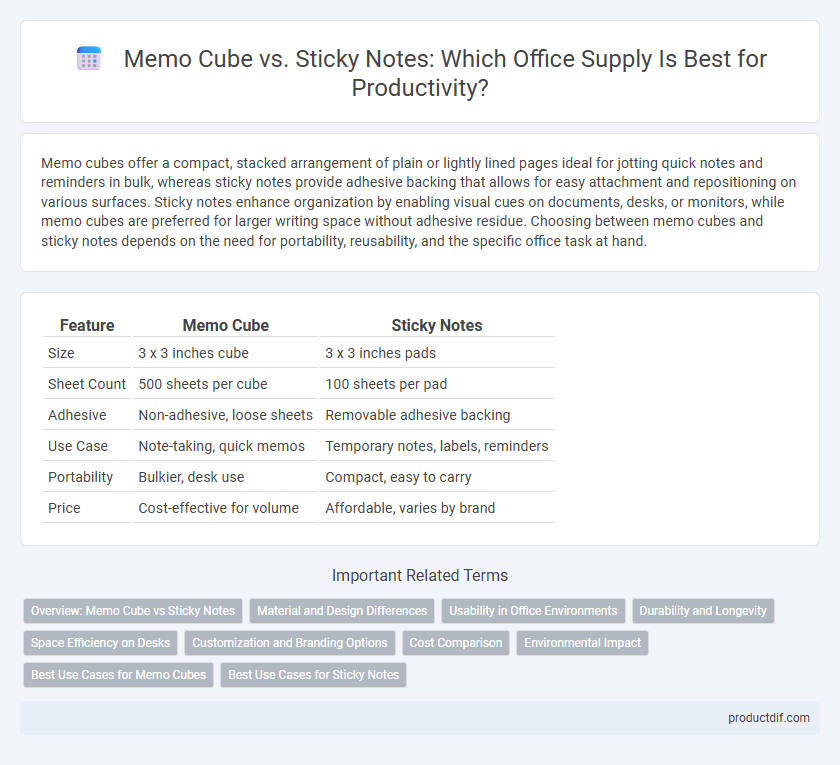Memo cubes offer a compact, stacked arrangement of plain or lightly lined pages ideal for jotting quick notes and reminders in bulk, whereas sticky notes provide adhesive backing that allows for easy attachment and repositioning on various surfaces. Sticky notes enhance organization by enabling visual cues on documents, desks, or monitors, while memo cubes are preferred for larger writing space without adhesive residue. Choosing between memo cubes and sticky notes depends on the need for portability, reusability, and the specific office task at hand.
Table of Comparison
| Feature | Memo Cube | Sticky Notes |
|---|---|---|
| Size | 3 x 3 inches cube | 3 x 3 inches pads |
| Sheet Count | 500 sheets per cube | 100 sheets per pad |
| Adhesive | Non-adhesive, loose sheets | Removable adhesive backing |
| Use Case | Note-taking, quick memos | Temporary notes, labels, reminders |
| Portability | Bulkier, desk use | Compact, easy to carry |
| Price | Cost-effective for volume | Affordable, varies by brand |
Overview: Memo Cube vs Sticky Notes
Memo cubes offer larger sheets stacked in a neat block, providing ample space for detailed messages and easy tear-off convenience. Sticky notes feature adhesive backing for quick attachment on various surfaces, making them ideal for reminders and annotations. Both cater to different organizational needs, with memo cubes emphasizing volume and sticky notes prioritizing portability and surface adherence.
Material and Design Differences
Memo cubes typically use thicker, higher-quality paper with a smooth finish that enhances durability and writing clarity, while sticky notes are generally made from thinner, semi-transparent paper designed for easy adhesion and repositioning. The design of memo cubes features stacked, uniformly cut sheets that provide a clean, organized appearance suitable for longer notes, whereas sticky notes include a low-tack adhesive strip on the back for quick application and removal on various surfaces. These material and design differences make memo cubes ideal for extensive note-taking and sticky notes perfect for temporary reminders and annotations.
Usability in Office Environments
Memo cubes offer larger writable surfaces that enhance note-taking efficiency during meetings, whereas sticky notes provide versatile adhesive options for quick reminders on various office surfaces. Sticky notes excel in temporary annotations with their repositionable adhesive, while memo cubes are preferred for extensive message drafting with easy stack storage on desks. Choosing between memo cubes and sticky notes depends on task requirements, with both complementing organizational workflows in dynamic office environments.
Durability and Longevity
Memo cubes offer superior durability compared to sticky notes due to their thicker paper quality, making them less prone to tearing and curling over time. Sticky notes often lose their adhesive strength quickly, whereas memo cubes maintain their stickiness and structural integrity for longer periods. Choosing memo cubes ensures extended usability in high-traffic office environments where notes need to remain visible and intact.
Space Efficiency on Desks
Memo cubes offer superior space efficiency on desks by providing a compact, stacked format that reduces clutter and maximizes usable surface area. Sticky notes, while versatile, often spread out individually, occupying more space and creating a less organized workspace. Choosing memo cubes helps maintain a tidy desk environment ideal for productivity and quick note access.
Customization and Branding Options
Memo cubes offer larger surface areas for custom logos and detailed branding, making them ideal for promotional giveaways or corporate gifts. Sticky notes provide versatile shapes and colors, allowing companies to tailor designs for specific campaigns or departmental use. Both options enhance brand visibility, but memo cubes excel in providing a durable, high-impact branding platform.
Cost Comparison
Memo cubes generally offer a lower cost per sheet compared to sticky notes, making them a more economical choice for bulk use in office settings. Sticky notes tend to have adhesive properties that increase their price, especially for branded or specialty varieties. Businesses aiming to optimize office supply budgets often find memo cubes provide cost-effective versatility without the premium expense of sticky adhesives.
Environmental Impact
Memo cubes often use less adhesive compared to sticky notes, reducing chemical waste and making them more environmentally friendly. Sticky notes typically contain synthetic adhesives that can hinder recycling processes and contribute to landfill pollution. Choosing memo cubes made from recycled or sustainably sourced paper further minimizes environmental impact in office supply usage.
Best Use Cases for Memo Cubes
Memo cubes offer an ideal solution for quick, organized note-taking in office environments where space efficiency is crucial. Their stacked design allows for easy access and prevents paper clutter, making them perfect for jotting down meeting reminders, task lists, or messages. Unlike loose sticky notes, memo cubes maintain a uniform, professional appearance while enhancing productivity by keeping important notes consolidated in one place.
Best Use Cases for Sticky Notes
Sticky notes excel in quick reminders, temporary annotations, and color-coded organization within office environments. Their adhesive backing ensures easy placement on documents, computer monitors, and planners for instant visibility. Ideal for collaborative brainstorming sessions, sticky notes support agile idea-sharing and task prioritization.
Memo cube vs Sticky notes Infographic

 productdif.com
productdif.com